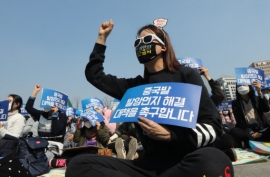Here is an interesting read in the Korea Times about how solar energy farms in South Korea are destroying the environment and impacting the livelihood of farmers:

Thousands of solar energy facilities have been built in rural mountainous regions in recent years, in line with a government policy to increase the ratio of renewable energy sources in the country’s energy mix.
Korea Times
However, many of them have become danger zones as the removal of trees for their construction has heightened the possibility of landslides, becoming a major headache for local residents during the nation’s annual rainy season. What is of more concern is that the installations are feared to end up destroying the landscape and environment through massive deforestation.
Seokdong Village in Gangjin County, South Jeolla Province, is one such village, where over 25,400 square meters of forest there were cut down to install solar panels in 2016.
But since then, soil has been washed away from the facilities during each summer’s rainy season, and in July this year two meters of stone embankments and 20 meters of barbed wire fencing collapsed.
“As the rain poured in July, the solar facilities collapsed and the village’s rice paddies were completely flooded. Fortunately, nobody was on site and hurt but if there had been, it would have caused many casualties,” Lim Jun-hyung, the village head, told The Korea Times, Friday. “The company that installed the panels won’t come to fix it for months, no matter how many times we call them. I can’t even stand the sight of those panels now.”
You can read more at the link, but what is ironic is that the Korean government is blaming global warming for the flooding and not the fact that huge swaths of forest were cut down to put in these solar farms. I also find it interesting that these farmers are not protesting and blockading these solar farms like the farmers blockading the THAAD site are which has done absolutely nothing to their crops.
By the way I am actually impressed the Korea Times actually published an article like this critical of solar farms. Generally it seems the media doesn’t want to report anything negative about green energy projects.

![Choi Byeong-am, second from left, chief of the Korea Forest Service, inspects logging sites at Duchon-myeon in Hongcheon County in Gangwon Monday afternoon alongside local officials. The Forest Service aims to plant 3 billion young trees over the next 30 years after logging aged trees in an attempt to offset carbon emissions, a plan being criticized by environmental activists. [NEWS1]](https://i0.wp.com/koreajoongangdaily.joins.com/data/photo/2021/05/17/cc224819-cf17-4333-a04c-402a978e045c.jpg?w=640&ssl=1)

.jpg/dims/resize/740/optimize)




